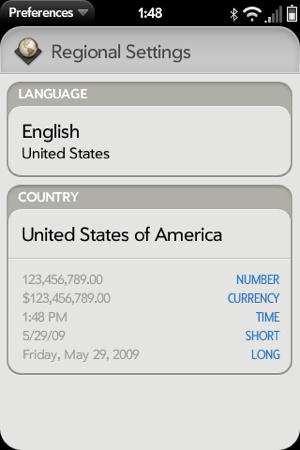Locales
Palm webOS defines a locale conventionally as a combination of language and region, and initially includes support for some Latin-1 languages and related regions. The first products will include all North and South American languages and regions as well as some of the Western European languages and regions.

Figure 11-1. A language preferences application
The choice of language indicates the primary localization, while the regional settings govern date formats, number formats, and similar types of data representation. You can mix any language and any region to create a locale. For example, en_DE is the English language and German regional settings. A complete list of supported languages and keyboard mappings is provided in Table 11-1, with some of the more common locales and regions.
Table 11-1. Supported Languages and Regions
Locale | Language | Region | Keyboard |
|---|---|---|---|
en_US | English (en) | United States (US) | QWERTY |
en_GB | English (en) | Great Britain (GB) | QWERTY |
en_IE | English (en) | Ireland (IE) | QWERTY |
es_US | Spanish (es) | United States (US) | QWERTY |
es_ES | Spanish (es) | Spain (ES) | QWERTY |
en_CA | English (en) | Canada (CA) | QWERTY |
| fr_CA | French (fr) | Canada (CA) | AZERTY |
de_DE | German (de) | Germany (DE) | QWERTZ |
it_IT | Italian (it) | Italy (IT) | QWERTY |
fr_FR | French (fr) | France (FR) | AZERTY |
The architecture is capable of supporting most single-byte and double-byte locales, but the initial release does not include the necessary fonts, input methods, and some ...
Get Palm webOS now with the O’Reilly learning platform.
O’Reilly members experience books, live events, courses curated by job role, and more from O’Reilly and nearly 200 top publishers.

